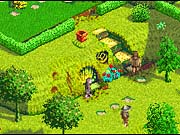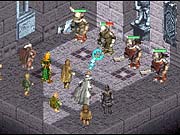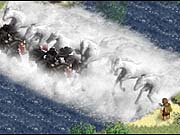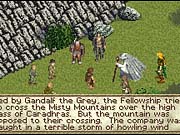The Lord of the Rings: The Fellowship of the Ring for the Game Boy Advance is based on the first book in J.R.R. Tolkien's immensely popular fantasy series. For fans of the novels, as well as for those who enjoyed the recent motion picture, this game offers the chance to wander around a digital replica of Middle-earth. But that's about all it offers. The range of interactivity is so low and the action is so infrequent that Frodo's quest to Mount Doom is reduced to nothing more than a trivial errand. What's more, the entire game is so unpolished and full of bugs that it's unfathomable how it ever passed quality assurance in the first place.

In the game, you play the role of Frodo, a young hobbit given the task of protecting the One Ring from Sauron, who himself originally forged it atop Mount Doom centuries prior. A prophecy foretells that nine kindred souls will form an alliance--a fellowship--to accompany Frodo on this long journey. The game begins where the book begins, in Hobbiton, and ends where the book ends, along the banks of the Anduin. The design of Fellowship of the Ring is similar to that of most role-playing games. There are people to talk to in every village who can offer advice or give you items that will prove invaluable throughout your quest. To get some of these items, you'll have to perform favors, such as retrieving a feather for Tom Bombadil before he'll help you rescue your friends from Old Man Willow in the old forest. Over the course of your travels, you'll also encounter a wide variety of trolls, orcs, wild dogs, and other dangerous creatures. Contact with these monsters inevitably leads to battle, during which each character takes turns attacking single or multiple enemies.
Although the description sounds nice on paper, Fellowship of the Ring really isn't any fun to play. The favors you'll perform are remarkably simple but often sidetrack the game to the extent that you'd just as soon avoid them. The game's battles are even worse. They're turn-based, which isn't a bad thing, but they're incredibly slow. You actually have to wait while each character slowly walks toward his target, makes an attack, and steps back into line. At the same time, the enemy always has the privilege of first attack, which means that it can be anywhere from 30 seconds to a minute before you even have a chance to retaliate. As it is, combat is pretty basic. The only available options are to attack with a sword, throw fireworks, defend, heal, or flee.

Ironically, although each battle takes forever to finish, you don't gain experience from any of them. Instead, you acquire health and skill upgrades automatically at various points throughout the story. While this is an innovative aspect, it just makes all of the time you'll spend in battle that much more frustrating.
The game's plot exposition is terribly light as well. You'll encounter all of the major characters, as well as a few peripheral ones, but none of them possess even half of the personality and dignity that they showed in the book. Barliman Butterbur, the barkeep in Bree, is reduced to nothing more than an innkeeper, rather than the knowledgeable informant who helps Frodo flee the rampaging Nazgul. The Nazgul themselves also play a somewhat diminished role. Instead of tracking the group to Bree and forcing a tense confrontation at Bruinen, they just block the road in various spots and later spring an ambush. Not once is it ever explained that these nine evil servants bear rings similar to Frodo's. You can't expect a video game to include every event and conversation from a 430-page novel, but Fellowship of the Ring doesn't even try.
Despite its minimal dialogue, the game does at least follow the progression of the book. Just as in the text, you'll start in Hobbiton, make your way through the old forest to Bree, and pass through Weathertop and Rivendell en route to Lothlorien and the final scene at Anduin. Unfortunately, this faithful pacing will prove a drawback for some players, as it limits your ability to explore and forces you from one location to the next. Once you've made your way to the next landmark, you can't go back. This creates the potential to leave important items behind, such that you may have to start over.

Worse yet, Fellowship of the Ring was shipped to retail with a number of software bugs present. Once in a while, you'll encounter enemies who won't attack you--you can just walk right through them. You can repeatedly enter and leave some areas to find duplicated items. A good example of this occurs after you meet Gildor. Off to the left, you'll find a house that constantly spawns gold pieces. While these glitches are unfortunate, they are at least helpful. As you continue playing, however, you'll encounter even more bugs, some of which are outright disastrous. There are two different areas where you'll experience a fatal crash that simply halts the game. One of these is avoidable, since it occurs during an optional side quest, but the other is not. About 80 percent into the game, deep in the mines of Moria, your game will just stop responding altogether, and you won't be able to play any further. Black Label Games has a workaround that involves pausing and saving your game right before you enter the problematic area, but it's not foolproof.

For the few brief hours that you can actually play the game, you're treated to a no-frills rendition of Middle-earth. Locations are brought to life accurately and with the necessary landmarks, but the overall color depth is minimal, and there's absolutely no animation present for minutiae like rivers, torches, or fog. Similarly, characters are faithful to their descriptions in the book, but they don't really move except to walk around or lunge during battle. The game's audio is equally plain. There are a few sound effects and a couple of digitized voices, but other than that, you won't hear very much at all. For whatever reason, the wonderful orchestral background music kicks in only at infrequent intervals.
Do yourself a favor and save the $30 you'd spend on this game. Despite whatever half-decent qualities this game might have, it ultimately butchers the story it's based on into a remarkably dull role-playing game--a game that you possibly won't even be able to finish.